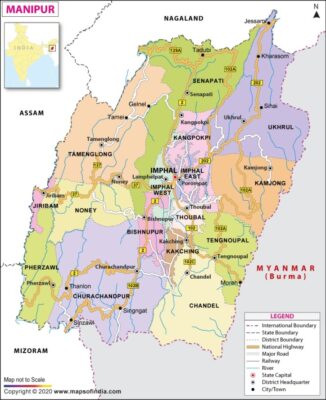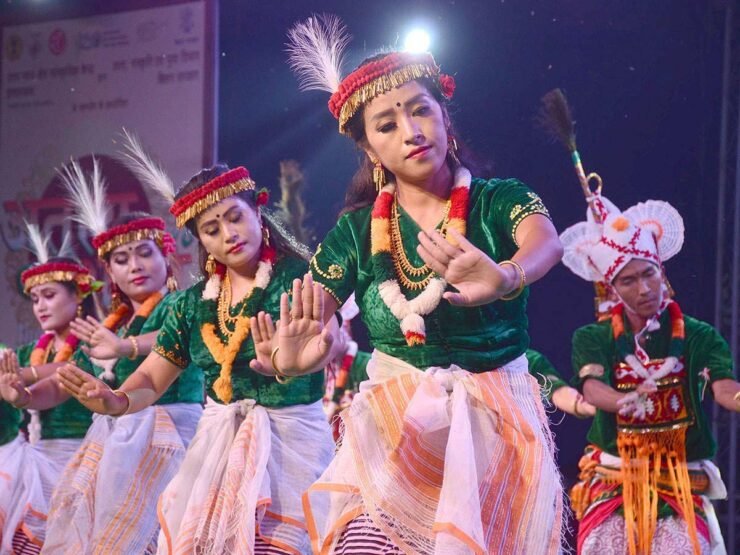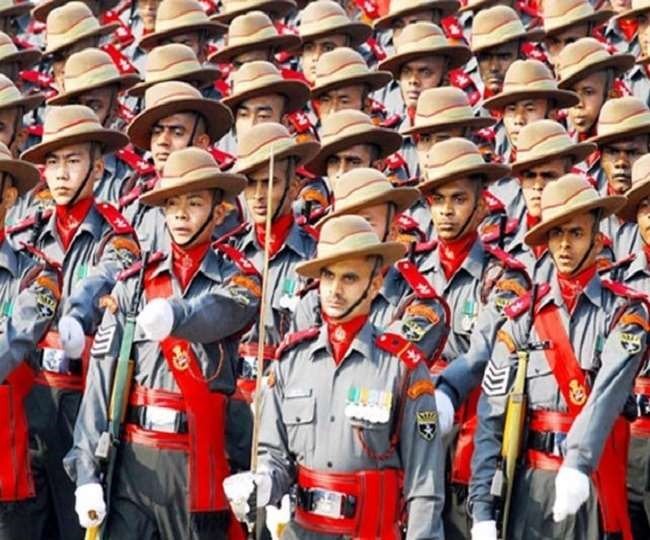 A convoy consisting of seven light vehicles was returning from a forward post of F Company, 46 Assam Rifles at 1000 hours on November 13, 2021. Col Vipalav Tripathi, the commandant, was travelling in second vehicle, a black Mahindra bolero, duly protected by armed escorts. He had taken his wife Anuja and son Abir also, for a civic action function in Senkhen village of Singhat subdivision of District Churachandpur in Southern Manipur area. At 1030 am, the motorcade crossed Senkhan village and was proceeding to Thinghat highway and negotiating a S curve in an isolated thick jungle patch in the hilly area. He felt that there was unusual calm. His sixth sense alerted him, and he cocked his AK 47, but he was too late. The first vehicle was blown up by a high intensity IED blast.
A convoy consisting of seven light vehicles was returning from a forward post of F Company, 46 Assam Rifles at 1000 hours on November 13, 2021. Col Vipalav Tripathi, the commandant, was travelling in second vehicle, a black Mahindra bolero, duly protected by armed escorts. He had taken his wife Anuja and son Abir also, for a civic action function in Senkhen village of Singhat subdivision of District Churachandpur in Southern Manipur area. At 1030 am, the motorcade crossed Senkhan village and was proceeding to Thinghat highway and negotiating a S curve in an isolated thick jungle patch in the hilly area. He felt that there was unusual calm. His sixth sense alerted him, and he cocked his AK 47, but he was too late. The first vehicle was blown up by a high intensity IED blast.
The CO Vehicle stalled and the driver applied sudden brakes. After IED blast, all hell broke loose. The insurgents firing party opened up with intense rate firing from almost point blank range from both sides of hills. The commanding officer, his wife and child suffered multiple gunshot wounds. His vehicle had 81 bullet holes. The first vehicle had around 10 bullet hits and third vehicle was hit with 45 bullet marks. The escort vehicle troops retaliated but hostile fire also knocked them down. The first three vehicles were trapped in the killing zone.
The convoy was split into two groups with another IED blast. The firing lasted just 20 minutes and ambush party withdrew and vanished. The toll was heavy. The CO and his family and four escorts were killed and other four soldiers of Quick Reaction Team were severely injured. Meanwhile, the other vehicles also had to halt. The troops dismounted for counter ambush drill. The exchange of fire lasted for 30 minutes and as insurgents made speedy withdrawal and escaped in thick jungles and by late night crossed over to Myanmar underground camp.
The reserve columns reached within an hour. The dead and injured were evacuated to Churachandpur and later to Imphal AR Hospital by MI 17. Tranquillity of Northeast was shattered after a peaceful period of 5 years. Earlier, on June 4, 2015, a convoy of Dogra battalion was ambushed in neighbouring Chandel district in which 18 Soldiers were killed and 35 troops were critically injured. The Special Forces had carried out a trans-border raid on Insurgent camps on June 9, 2015 and destroyed two camps and killed approx 100 insurgents in a surgical strike.
Manipur is known as the Jewel of Northeast. A small but beautiful land locked state with an area of 22,327 sq km. Manipur acceded to the Indian Union on September 21, 1949 and was granted full state hood on January 21, 1972. It has state of Nagaland to its north, Assam in the west and Mizoram in the southwest. Eastern and south-eastern border touches Myanmar. There are 9 districts in the state namely Bishnupur, Chandel, Churachandpur, Imphal East, Imphal West, Senapati, Tamenlong, Thoubal, and Ukhrul. The total population is approx. 29 Lakhs divided in to three ethnic groups. Meiteis, Nagas and Kukis. There are two topographical zones. Hills to the north and valley/plains to the south. Known for ethnic and cultural diversity, the 65 % of population lives in Imphal valley and only 35 % dwell in hilly zone which accounts for 90% of the total land mass of Manipur. Manipur is on the forefront of present government’s Look East Policy and correctly called the Gateway to Southeast Asia. Manipur athletes and players are forming core of Indian man and woman boxing teams, football team and hockey teams. World Champion and Olympic bronze medallist MC Mary Kom is a legend in International boxing. Meerabai Chanu and N Kunjarani are other two Olympian weightlifters, who earned bronze and silver medal for India. Manipur is on path of development and forms a solid integral part of India. Manipuri soldiers have depicted their bravery in many a wars India has fought.

Manipur is a traditional society and sharply divided in to three major ethnic groups – Hindu Meiteis, who live in plains, in valley is the dominant group. Nagas is the second important ethnic group, who are protestant Christians and generally live in mountains and third tribal group is Kukis. Due to strong tribal identity, these divisions are further pronounced and each group has own set of demands based on perceived historical wrongs resulting in to fault lines of mistrust. Meities from valley dominate the political scene generally occupying 2/3 of the assembly seats and leaving others to the fringes of power. The lopsided development and lack of governance also add fuel to fire. The insurgent groups also gain strength from respective ethnicities. Meiti insurgent group (People Liberation Army PLA, People Revolutionary party of Kangleipak, PREPAK) are secessionist and want to restore pre merger status. Naga insurgency (Manipur Naga National front, NSCN) is linked to demand of sovereign” Nagalim “comprising of Naga majority areas of Nagaland, Manipur, Assam, Arunachal Pradesh and also Myanmar. The Kukis (Kuki Natonal Army) want an autonomous Kukiland with in Manipur to safeguard their own interests. Each Ethnic group, continue to sustain armed groups to fulfil their aims and prevent any settlement with union govt.
The insurgency started in Manipur in Naga dominated area in 1950s as an extension of insurgency in Nagaland. It subsided with signing of accord by Naga National Council with Indian Government and Nagaland was given a statehood. Meanwhile, Meities demanding a separate state, started insurgency movement in 1970s .The Kuki insurgency mushroomed as to counter ethnic cleansing by Nagas of Kuki population from hills.
Over the years, with development and education and favourable Northeast policy, peace accords, the issues have become irrelevant and realising that with strong central government, the aims desired are not achievable. This has resulted in to ideology withering away and replaced by personal gains and ambitions. Naglim is a distant dream as two countries and 4 states are involved. Statehood had been granted to Manipur in 1972. Kukis also feel safe comparatively. The proximity to Golden Drug Triangle has added new dimension to insurgency. Drug Mafias with origin in South East Asian countries especially Thailand and Myanmar, have involved the insurgent groups to facilitate smuggling of drugs, timber and other contraband in turn are rewarded with black funds and illegal arms and ammunition.

Assam Rifles, the sentinels of the Northeast, were raised in 1835, as the Cachar Levy, is the oldest Para Military force of India. The force is headed by Lt Gen Pradeep Chandran Nair, Director General located at Shillong, Meghalaya. It is further divided into three Inspector Generals, North, South and East and 12 sectors. There are presently 46 Assam Rifles battalions. The force has provided a yeoman service in seven sister states, by protecting Indo Myanmar Border and strengthening Counter Insurgency Grid and providing relief and assistance to the people of Northeast by dedicating humanitarian help in times of disasters. They are truly nicknamed as the Friends of the Hill People.
The insurgency in Manipur is complicated as there are too many stake holders and assorted militant groups with different ideology. The menace can be tackled with following measures. Firstly, the state government should give good and impartial governance. Youth of Manipur is really talented. They must be gainfully employed as soldiers in Army or Para military units and to be inducted in to state/ National teams. A reliable grievance mechanism to be installed. State administration should outreach remote areas. Secondly, economic development is key to prosperity and tranquillity. The infrastructure projects must be undertaken to enhance connectivity with rest of India. Thirdly, effective law enforcement agency will generate order and discipline. The police should be impartial but firm and fully trained and equipped to deal with blockades and riots. Fourthly, community development projects should be initiated with help of women ho ho, village councils, student organisations, church / temple associations. Fifthly, have cordial military and civil relations with Myanmar. Both countries needs to carry out joint operations against Insurgent Organisation and share intelligence. No safe heavens should be permitted. Myanmar can become India’s Land Bridge to Southeast Asia. We must develop trilateral super highway and rail links connecting three nations; Thailand, Myanmar and India and have military agreements against terrorism.
The present environment provides government to engage various Insurgent groups in peace talks while Security forces (SFs) should maintain pressure. A synergised Counter Insurgency operation strategy involving all agencies can sustain normalcy in the state enabling development and lasting peace.
Security Forces cannot lower their guards while engaged in civic and humanitarian projects and should maintain adequate human intelligence network. Counter Insurgency is tricky game and has to be played with alertness and ruthlessness while maintaining a mask of cordiality with masses. A surgical strike is on the horizon at the time and place decided by the military hierarchy.
-The writer is an Indian Army veteran and a defence analyst. He has keen interest in Geo-strategic affairs and writes regularly on internal and external affairs issues related to India and neighbours. The views expressed are personal and do not necessarily reflect the views of Raksha Anirveda.








